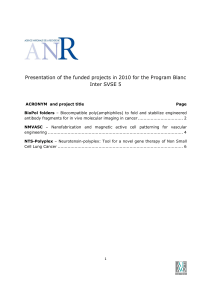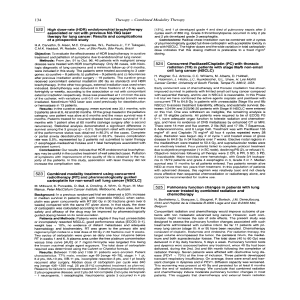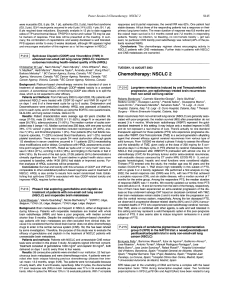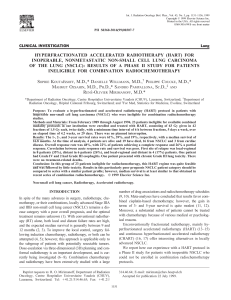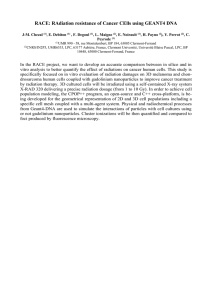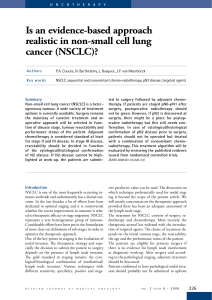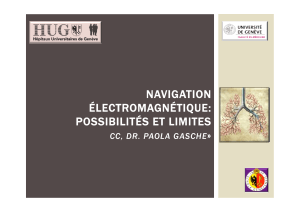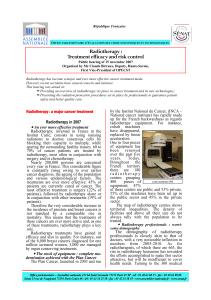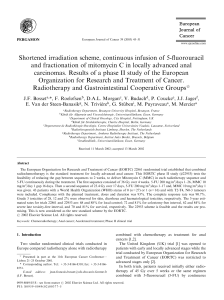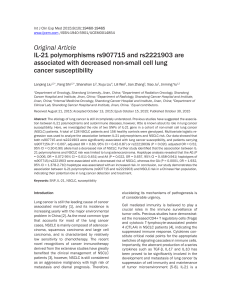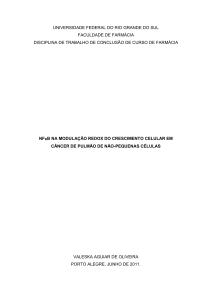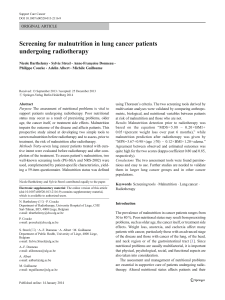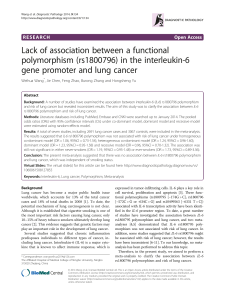s134
publicité
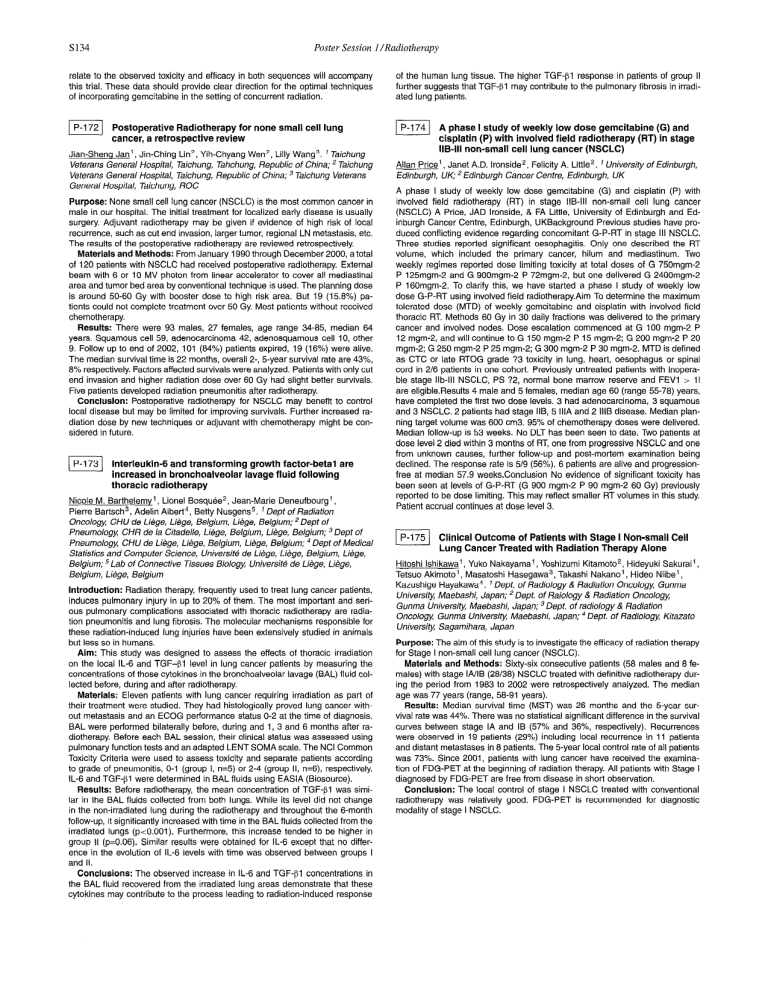
s134 Poster Session I/Kadiotherupy relate to the observed toxicity and efficacy in both sequences will accompany this trial. These data should provide clear direction for the optimal techniques of incorporating gemcitabine in the setting of concurrent radiation. of the human lung tissue. The higher TGF-PI response in patients of group II further suggests that TGF-BI may contribute to the pulmonary fibrosis in irradiated lung patients. I P 172 ElP 174 Postoperative Radiotherapy for none small cell lung cancer, a retrospective review Jian-Shena Jan’, Veferans Genera/ Veterans General Genera/ Hospital, Jin-Ching Hospital, Hospital, Taicbung, Lit?, Yih-Chyang Wen’, Lilly Wang3. ’ Taichung Taichung, Tahchung, Republic of China; 2 Taichung Taichung, Republic of China; 3 Taichung Veterans ROC Purpose: None small cell lung cancer (NSCLC) is the most common cancer in male in our hospital. The initial treatment for localized early disease is usually surgery. Adjuvant radiotherapy may be given if evidence of high risk of local recurrence, such as cut end invasion, larger tumor, regional LN metastasis, etc. The results of the postoperative radiotherapy are reviewed retrospectively. Materials and Methods: From January 1990 through December 2000, a total of 120 patients with NSCLC had received postoperative radiotherapy. External beam with 6 or IO MV photon from linear accelerator to cover all mediastinal area and tumor bed area by conventional technique is used. The planning dose is around 50-60 Gy with booster dose to high risk area. But 19 (15.8%) patients could not complete treatment over 50 Gy. Most patients without received chemotherapy. Results: There were 93 males, 27 females, age range 34-85, median 64 years. Squamous cell 59, adenocarcinoma 42, adenosquamous cell 10, other 9. Follow up to end of 2002, 101 (84%) patients expired, 19 (16%) were alive. The median survival time is 22 months, overall 2-, 5-year survival rate are 43%, 8% respectively. Factors affected survivals were analyzed. Patients with only cut end invasion and higher radiation dose over 60 Gy had slight better survivals. Five patients developed radiation pneumonitis after radiotherapy. Conclusion: Postoperative radiotherapy for NSCLC may benefit to control local disease but may be limited for improving survivals. Further increased radiation dose by new techniques or adjuvant with chemotherapy might be considered in future. I P 173 Interleukin-6 and transforming growth factor-beta1 are increased in bronchoalveolar lavage fluid following thoracic radiotherapy Nicole M. Barthelemy’, Lionel BosquBe2, Jean-Marie Deneufbourg’ , Pierre !3artsch3, Adelin Albert4, Betty Nusgenss. ‘Dept of Radiation Oncology CHU de Ligge, Li&ge, Belgium, Likge, Belgium; ‘Dept of Pneumology CHR de /a Citadel/e, Li&ge, Selgium, Li&ge, Belgium; 3 Dept of Pneumology CHU de Li&ge, Li.&ge, Belgium, Likge, Belgium; 4 Dept of Medical Statistics and Computer Science, Universit6 de Liege, Li.+ge, Belgium, LMge, Belgium; 5 Lab of Connective Tissues Biology, Universit6 de Liege, Likge, Belgium, Li&ge, Belgium Introduction: Radiation therapy, frequently used to treat lung cancer patients, induces pulmonary injury in up to 20% of them. The most important and serious pulmonary complications associated with thoracic radiotherapy are radiation pneumonitis and lung fibrosis. The molecular mechanisms responsible for these radiation-induced lung injuries have been extensively studied in animals but less so in humans. Aim: This study was designed to assess the effects of thoracic irradiation on the local IL-6 and TGF-fil level in lung cancer patients by measuring the concentrations of those cytokines in the bronchoalveolar lavage (BAL) fluid collected before, during and after radiotherapy. Materials: Eleven patients with lung cancer requiring irradiation as part of their treatment were studied. They had histologically proved lung cancer without metastasis and an ECOG performance status O-2 at the time of diagnosis. BAL were petformed bilaterally before, during and 1, 3 and 6 months after radiotherapy. Before each BAL session, their clinical status was assessed using pulmonary function tests and an adapted LENT SOMA scale. The NCI Common Toxicity Criteria were used to assess toxicity and separate patients according to grade of pneumonitis, O-1 (group I, n=5) or 2-4 (group II, n=6), respectively. IL-6 and TGF-PI were determined in BAL fluids using EASIA (Biosource). Results: Before radiotherapy, the mean concentration of TGF-61 was similar in the BAL fluids collected from both lungs. While its level did not change in the non-irradiated lung during the radiotherapy and throughout the 6-month follow-up, it significantly increased with time in the BAL fluids collected from the irradiated lungs (p<O.OOi). Furthermore, this increase tended to be higher in group II (p=O.O6). Similar results were obtained for IL-6 except that no difference in the evolution of IL-6 levels with time was observed between groups I and Ii. Conclusions: The observed increase in IL-6 and TGF-PI concentrations in the BAL fluid recovered from the irradiated lung areas demonstrate that these cytokines may contribute to the process leading to radiation-induced response A phase I study of weekly low dose gemcitabine (G) and cisplatin (P) with involved field radiotherapy (RT) in stage IIB-Ill non-small cell lung cancer (NSCLC) Allan Price’, Janet A.D. Ironside”, Felicity A. Little2. ’ University of Edinburgh, Edinburgh, UK; ‘Edinburgh Cancer Centre, Edinburgh, UK A phase I study of weekly low dose gemcitabine (G) and cisplatin (P) with involved field radiotherapy (RT) in stage 118-111non-small cell lung cancer (NSCLC) A Price, JAD Ironside, & FA Little, University of Edinburgh and Edinburgh Cancer Centre, Edinburgh, UKBackground Previous studies have produced conflicting evidence regarding concomitant G-P-RT in stage Ill NSCLC. Three studies reported significant oesophagitis. Only one described the RT volume, which included the primary cancer, hilum and mediastinum. Two weekly regimes reported dose limiting toxicity at total doses of G 750mgm-2 P 125mgm-2 and G 900mgm-2 P 72mgm-2, but one delivered G 2400mgm-2 P 160mgm-2. To clarify this, we have started a phase I study of weekly low dose G-P-RT using involved field radiotherapy.Aim To determine the maximum tolerated dose (MTD) of weekly gemcitabine and cisplatin with involved field thoracic RT. Methods 60 Gy in 30 daily fractions was delivered to the primary cancer and involved nodes. Dose escalation commenced at G 100 mgm-2 P 12 mgm-2, and will continue to G 150 mgm-2 P 15 mgm-2; G 200 mgm-2 P 20 mgm-2; G 250 mgm-2 P 25 mgm-2; G 300 mgm-2 P 30 mgm-2. MTD is defined as CTC or late RTOG grade 73 toxicity in lung, heart, oesophagus or spinal cord in 2/6 patients in one cohort. Previously untreated patients with inoperable stage Ilb-Ill NSCLC, PS ?2, normal bone marrow reserve and FEVI > II are eligible.Results 4 male and 5 females, median age 60 (range 55-78) years, have completed the first two dose levels. 3 had adenocarcinoma, 3 squamous and 3 NSCLC. 2 patients had stage IIB, 5 IIIA and 2 IIIB disease. Median planning target volume was 600 cm3. 95% of chemotherapy doses were delivered. Median follow-up is 53 weeks. No DLT has been seen to date. Two patients at dose level 2 died within 3 months of RT, one from progressive NSCLC and one from unknown causes, further follow-up and post-mortem examination being declined. The response rate is 5/9 (56%). 6 patients are alive and progressionfree at median 57.9 weeks.Conclusion No evidence of significant toxicity has been seen at levels of G-P-RT (G 900 mgm-2 P 90 mgm-2 60 Gy) previously reported to be dose limiting. This may reflect smaller RT volumes in this study. Patient accrual continues at dose level 3. El-P 175 Clmical Outcome of Patients with Stage I Non-small Cell Lung Cancer Treated with Radiation Therapy Alone Hitoshi Ishikawa’, Yuko Nakayama I, Yoshizumi Kitamotoz, Hideyuki Sakurai’, Tetsuo Akimoto’ , Masatoshi Hasegawa3, Takashi Nakano’ , Hideo Niibe’ , Kazushige Hayakawa4. ’ Dept. of Radiology & Radiation Oncology Gunma University, Maebashi, Japan; 2 Dept. of Raiology & Radiation Oncology, Gunma University, Maebashi, Japan; 3 Dept. of radiology & Radiation Oncology, Gunma Universifl: Maebashi, Japan; 4 Dept. of Radiology, Kitazato University, Sagamihara, Japan Purpose: The aim of this study is to investigate the efficacy of radiation therapy for Stage I non-small cell lung cancer (NSCLC). Materials and Methods: Sixty-six consecutive patients (58 males and 8 females) with stage IAfIB (28/38) NSCLC treated with definitive radiotherapy during the period from 1983 to 2002 were retrospectively analyzed. The median age was 77 years (range, 58-91 years). Results: Median survival time (MST) was 26 months and the 5-year survival rate was 44%. There was no statistical significant difference in the survival curves between stage IA and IB (57% and 36%, respectively). Recurrences were observed in 19 patients (29%) including local recurrence in 11 patients and distant metastases in 8 patients. The 5-year local control rate of all patients was 73%. Since 2001, patients with lung cancer have received the examination of FDG-PET at the beginning of radiation therapy. All patients with Stage I diagnosed by FDG-PET are free from disease in short observation. Conclusion: The local control of stage I NSCLC treated with conventional radiotherapy was relatively good. FDG-PET is recommended for diagnostic modality of stage I NSCLC.




